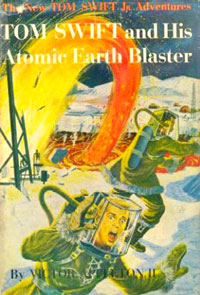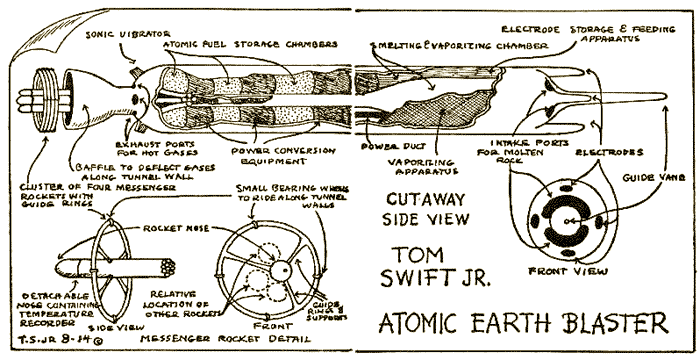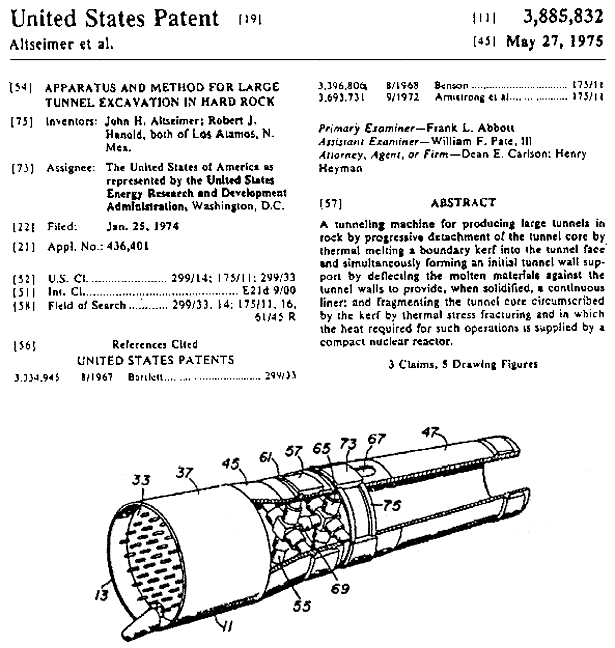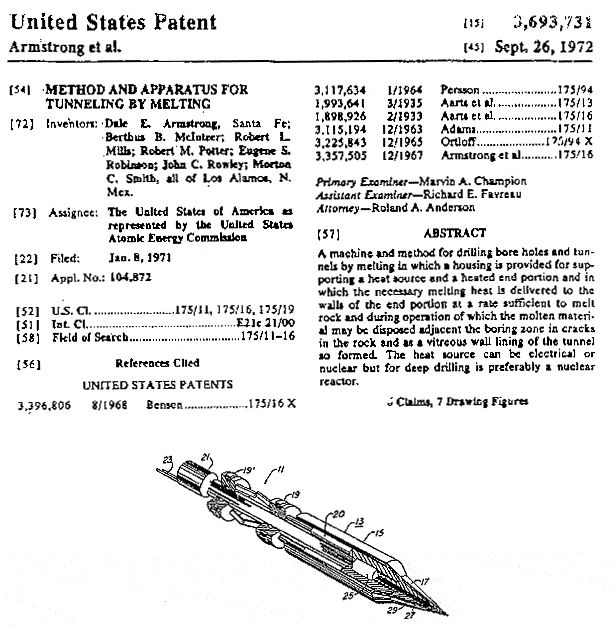|

by Victor Appleton II
from
TomSwift Website
Summary:
 Extracted
from the dustjacket flap of the book: Extracted
from the dustjacket flap of the book:
Furious Antarctic storms and
ruthless enemies stalk Tom Swift Jr. And his latest atomic
invention, the earth blaster, in book number five of this
thrilling science-adventure series.
When Tom chooses the South Pole as the spot to hunt for molten
iron with his earth blaster, his closest friends raise their
eyebrows. Even Chow Winkler, the expedition's genial Texan cook,
says, "Brand my thermopile, if the young inventor ain't plumb
loco!"
First Tom has to convince the skeptics about the value of his
earth blaster. Preliminary tests prove that it is one of the
greatest inventions the world has ever known.
When spies of the Kranjovian government learn about the project,
it becomes a race to see who will reach the South Pole first.
Tom risks his life and al the funds of Swift Enterprises to
launch the expedition. With his pal Bud Barclay, Chow, and a
group of top-flight technicians, he braves the white fury of the
Antarctic ice barriers to set up operations. But the Kranjogians
seem to have beaten him to it!
In the nerve-racking and chill-packed days that follow, the
young inventor is faced with one of the greatest challenges in
his career. The outcome hangs in the balance down to the last
page of this dynamic story. Read it to see how Tom Swift Jr.
startles the world when his atomic earth blaster starts the most
phenomenal gusher known to man!
Major Inventions
This summary below was written by
Graeme Woods
The most important invention in this
book is the Atomic Earth Blaster. The Atomic Earth Blaster is an
automated tunneling machine. Tom builds a prototype version that
uses mechanical cutters to grind up rocks and dirt before
progressing to the final model that uses atomic energy to vaporize
rock. The Atomic Earth Blaster is used to drill down to a molten
layer of iron deep beneath the earth's crust.
How does
the Atomic Earth Blaster work?
This book is unique in my collection of Tom Swift books in that it
includes a diagram of the Atomic Earth Blaster:

The mechanical Atomic Earth Blaster is
nuclear powered, but uses traditional grinding tools to cut into
rock. This is similar to existing tunneling tools except that it
uses nuclear power. However it appears to be a lot faster, as most
tools of this type cut quite slowly.
The vaporizing blaster is different as Tom describes to Chow:
"That sure is a mean-lookin'
contraption you got parked outside!" the cook added. "Is that
what you're diggin' through to China with?"
"Not exactly." Tom grinned. "That's only my experimental model.
The blaster we take down to the South Pole will be somewhat
different."
"How different?"
"Well, look at these drawings. Instead of those digging devices
you see sticking out the front end of our experimental model,
the new one will have four electrodes spaced around the nose and
a long guide vane sticking right out of the center."
"What's the idea o' them things?" Chow asked.
"Well, you see, the old model just ground up dirt and rocks
mechanically. But on my new blaster, these electrodes sticking
out the front will melt any rock on contact. Then the molten
liquid will be drawn in through these intake ports, and further
smelting will take place inside the machine. The resulting hot
gases will jet out through these exhaust ports at the rear."
This is how Tom describes the operation
of the blaster in tunneling down to the molten iron:
"Instead of using the atomic energy
to grind up the dirt and rocks, we could use it to power an
electric smelter. This would release gaseous oxygen from the
melted rock. And the gas in turn would billow up the shaft,
carrying the particles of ore dust with it so we wouldn't need a
conveyor."
The blaster is remote controlled and is
launched into the earth from a launching gantry as Tom describes to
Mr. Swift:
"Here's a sketch of the launching
platform I've designed for the South Pole blaster," Tom said,
spreading out a blueprint on his father's desk.
The structure was composed of girders
and I beams, and looked somewhat like an upside-down rocket
launching platform. Rails were provided to guide the machine on its
take-off.
Mr. Swift studied the drawing carefully.
"I believe this will do the trick,
all right, son," he commented. "Of course your machine will only
have room for a bare minimum of sheathing around the atomic
pile, and that will make things much more difficult. It means
the launching will have to be done by remote control to make
sure you and the others are exposed as little as possible to
dangerous radiation"
Tom nodded thoughtfully. "I've already
provided for that, Dad." He went on to describe the remote-control
system by which he planned to operate the machine.
To withstand the high temperatures, the polar blaster is made of
chrome-nickel-moly (although the prototype is made of mild steel to
reduce costs). It also has its own cooling system and internal
guidance system:
For one thing, he must adapt the
cooling system, invented for his giant robot, for use in the
earth blaster. This system used a highly paramagnetic fluid
which was alternately magnetized and demagnetized. The fluid was
circulated through the vacuum tubes inside the robot and
controlled by a thermostat to maintain an ideal working
temperature of 96.4 Fahrenheit.
A similar system would be needed to
protect the instruments in the earth blaster from overheating. A
hundred miles down, the blaster would have to operate at
temperatures of several thousand degrees ñ hot enough to shrivel a
human being to ashes!
"And speaking of instruments", mused
Tom, "she'll need a gyroscope, too."
He smiled at the thought of what might
happen if the machine ever veered off course.
Would
the Atomic Earth Blaster work?
Before determining whether the Atomic Earth blaster would work as
described, it is interesting to note that several actual prototypes
of a similar machine called a nuclear subterrene have been tested
and patented by scientists at the Los Alamos National Laboratory, in
New Mexico. Three machines were patented, one in 1972 in the name of
the United States Atomic Energy Commission and two in the name of
the United States Energy Research and Development in 1975. The
information in a subsequent study indicates that work had been
progressing since the early 1960's.
U.S. Patent No.
3,885,832 dated May 27, 1975 shows a machine similar in appearance to Tom's
blueprint shown in the book:

U.S. Patent No. 3,693,731 dated Sept. 26, 1972
shows
a more needle-nosed machine:

The 1972 patent describes:
"a machine and method for drilling
bore holes and tunnels by melting in which a housing is provided
for supporting a heat source and a heated end portion and in
which the necessary melting heat is delivered to the walls of
the end portion at a rate sufficient to melt rock and during
operation of which the molten material may be disposed adjacent
the boring zone in cracks in the rock and as a vitreous wall
lining of the tunnel so formed. The heat source can be
electrical or nuclear, but for deep drilling is preferably a
nuclear reactor."
The nuclear heated subterrene uses a
compact nuclear reactor to transfer heat via liquid lithium to a
molybdenum nose that melts the rock. In the process of melting the
rock the lithium loses some of its heat. The lithium is then
circulated back along the exterior of the tunneling machine to help
cool the molten rock to form a vitrified tunnel lining. The cooled
lithium then circulates back to the reactor where the whole cycle
starts over. The alternative approach uses electrodes to melt the
rock.
The main difference between the blaster and the subterrene is that
the blaster has a second heating cycle that actually vaporizes the
rock (converts it from a liquid to gaseous state) rather than just
melting it. The vaporized rock is exhausted from the back of the
blaster.
Since the melting point of rock ranges from 700 degrees Celsius to
1300 degrees Celsius the boiling point of rock would not be too far
above this temperature. I therefore believe that it is possible to
make a machine out of materials that would support temperatures that
would allow rock to be vaporized. Refractory materials such as
carbon and hafnium carbide can withstand temperatures in excess of
3500 degrees Celsius. These temperatures would easily vaporize rock.
Tom's cooling system could keep the rest of the blaster at a safe
working temperature.
A carbon-arc could provide the necessary heat. If the rock were
heated with air, (perhaps from the oxygen created from smelting as
described by Tom) it would effectively "burn" which would allow the
temperature to be lowered. Also this would eliminate the problem of
the vaporized rock turning back into rock after exiting the blaster
and cooling. This is similar to some ablative tunneling systems that
use lasers to vaporize the rock.
In conclusion, I believe the atomic earth blaster is a possibility
because similar machines have been patented and materials are
available that would allow it to work as described. It is
interesting that "Tom Swift and His Atomic Earth Blaster" is
copyrighted in 1954, before the apparent development of the subterrene and it is also interesting that it contains such a
detailed diagram. Perhaps the Los Alamos scientists read the book,
or the idea was already being considered.
What
impact would the Atomic Earth Blaster have on our lives?
To answer this question, we need only look at the subterrene, which
is a similar machine. The U.S. Federal government conducted two cost
studies comparing the subterrene to conventional tunneling
technologies. In general, the subterrene could construct tunnels
more cheaply than conventional machines because of labour savings
and because the molten rock could line the tunnel. This cost
advantage was particularly evident with large tunnels or where the
rock conditions are very unfavourable.
I believe that it is now unlikely that the atomic earth blaster will
be commonly used because it is nuclear powered. When the book was
written, atomic energy was the way of the future, but since that
time the public's fear of atomic energy and the side effects of
exposure to radioactivity has increased and a machine that uses a
nuclear reactor is unlikely to gain widespread support. However the
blaster would be very useful.
A machine that would tunnel cheaply without the need for manual
operation would save lives in tunnel construction, which is often
very dangerous. Also the lower costs would allow more construction
of tunnels for roadways and trains, freeing up space on the surface.
An atomic earth blaster could also be used to construct tunnels and
underground shelters on the Moon or Mars. These could protect
astronauts against the harsh conditions and cosmic rays.
The blaster could also be used for mining, but not in the way
described in the book. The mantle of the earth (the layer below the
crust) is now known to not be pure iron, but consists of iron and
magnesium silicates, similar to a mineral called olivine. More
economical grades of ore are readily available on the surface
without the trouble of drilling through the earth's crust.
|

 Extracted
from the dustjacket flap of the book:
Extracted
from the dustjacket flap of the book:

